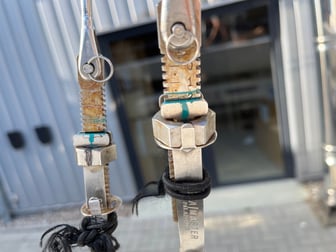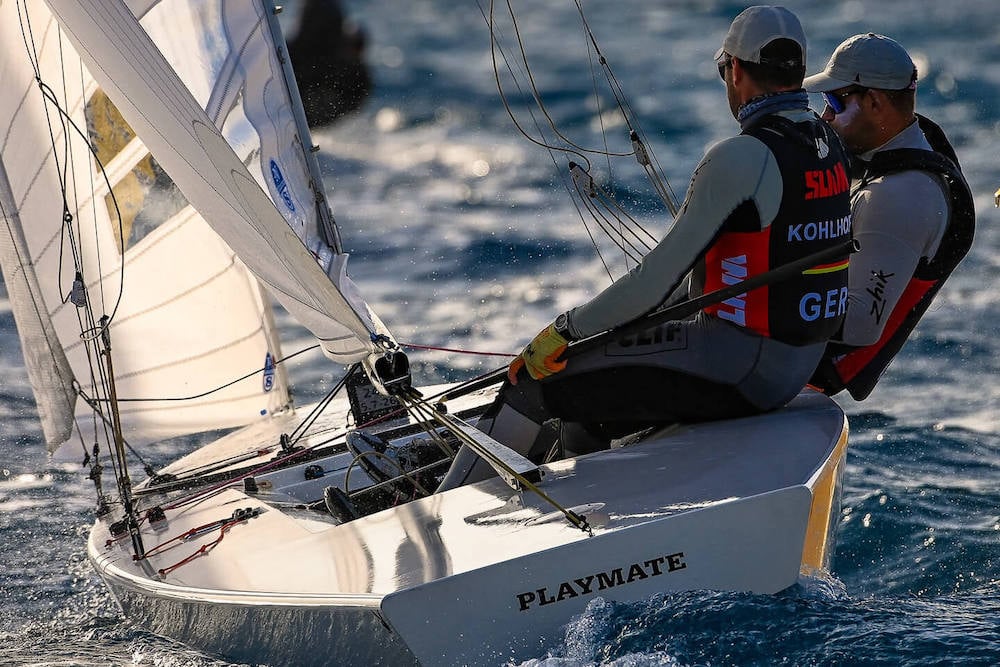Today we are speaking about deck hardware and rig setup to Max Kohlhoff, the winning helmsman of the 2023 Star Worlds. With Ole Burzinski from Flensburg Yacht Club, onboard Playmate, they recently scored two bullets out of six races in Scarlino, finishing the championship ahead of double Star World champion Diego Negri. They now join the long list of Star World Champions, that have raced annually since 1923, to claim this prestigious title.
The Star boat design, conceived in 1910, has evolved over the years, transitioning from the original Gaff rig and wooden spars to composite materials and modern boat deck hardware. However, it remains a classic sailing boat that requires tuning and adjustment for best performance. The mast of this 23ft (7m) boat is very long and thin (almost 10m to allow around 20 sq. m. of mainsail area), so it’s relatively easy to break, and requires careful control and handling.
Max's sailing expertise extends from a career in ILCA & Finn classes to now running the Kohlhoff Rigging company - a supplier of Gottifredi Maffioli ropes for Upffront.com. In a one-design class a lot comes down to sailing skills, but selection of the right deck hardware can make a significant difference on the water too.
We reached out to Max to find out what boat deck hardware he was using for his world championship campaign.
1. Star deck hardware key control - the Barney Post
The Barney post and side deck control lines, Max refers to as the "mission control for the helmsman". It's here that the numerous key control systems of deck hardware converge, offering precise control over various aspects of the boat. Max explains, "On the side deck we have the 2:1 course runner that has a snatch/ratchet block under the deck, which acts as a 90 degree deflector into two sets of cam cleats on the side deck. We use two inline cam cleats for security but also because it is very highly loaded due to the runners being very far forward in the boat.”

Image credit - © Max Kohlhoff
In the center of the Barney post is the mainsheet control. It turns out that Max is a big fan of old custom Frederiksen blocks! Although Frederiksen was acquired by Ronstan in 2001, Max's preference for this innovative Danish deck hardware brand remains strong. He explains, "I'm now running a custom, old-style, double ratchet block, because the Frederiksen ratchet sheaves were just amazing.
Ratchet blocks from most other manufacturers have these hexagonal sheaves. They offer a lot of grip but they end up distorting the line quite a lot. If you don't have a good line, it tends to become triangular in shape with ridges in highly loaded areas. When we’re sailing downwind,” Max continues, “I rely a lot on the feeling in the mainsheet, and you lose all this ‘feedback’ if the line is distorted. Also, the hexagonal sheaves rattle because they are not round, which makes the situation worse. That is why I love these Frederiksen inspired ratchet blocks – I also use them in my Finn - but it also highlights the importance of a good rope”.
2. Boat Ropes: The Backbone of Sailing
In the world of sailing, boat ropes are the unsung heroes, playing a pivotal role in ensuring control and precision. Max Kohlhoff relies on Gottifredi Maffioli for his Star boat and underlines the importance of choosing the right boat ropes. Each type of boat rope serves a specific purpose, tailored to the demands of different sailing manoeuvres:
- Jib Halyard: Max chooses the SK99 Ultra single braid, known for its low stretch and lightweight. This choice reflects his commitment to minimising stretch and optimising performance.
- Main Sheet: For the main sheet (on a Star boat you have a lot!) Max uses Gottifredi Maffioli TD78 6mm, featuring a Technora®/Dyneema® cover with an SK78 core.
- Jib Sheet: Max opts for SK99 DYCO 6mm for the jib sheet, combining a SK99 core with a Dyneema®/ Cordura® cover. The SK99 core offers precise control and the cover is light, durable and very grippy.
- Control Lines: Max relies on TD78/99. These ropes are chosen for their durability and consistency, crucial in high-pressure situations.
The above reflects Max’s overall preference for stiffer, tighter rope construction for his sheets compared to some of the performance softer ropes e.g. Gottifredi Maffioli Superswift, which many crews believe offers a better grip. He explains, "I find the softer ropes tend to elongate and reduce diameter under load which becomes more uncomfortable on long upwind legs. The tighter/stiffer ropes on the other hand retain their shape and diameter which makes them more comfortable to use, and the Technora®/Cordura® in the covers makes them super grippy. As previously mentioned, I prefer the tight/stiff construction in ratchet blocks and they also absorb less water and are therefore lighter! Given the Star's hefty main sheet load, I often wind it around my hand for that final pull.”
3. Rig Setup: Precision and Alignment

Max Kohlhoff's rig setup is a testament to the precision required in sailing this class. He emphasizes the high angle of the runners and the significant forward mast rake, both critical aspects of his boat's performance. In this setup, the Stamaster turnbuckles play a crucial role, maintaining the rig's alignment and tension. The Stamaster turnbuckles – probably haven’t changed design for 70 years! Functional but effective.
Max's dedication to alignment extends to meticulous calibration: "Pre-worlds, I invested two and a half evenings making sure the boat was completely levelled and then aligning the mast with a laser, to make sure it was in the middle of the boat. The Star mast is really thin and flexible, so the mast might look straight, but you don't know if it's maybe 10 centimeters off in the tip. You would just never be able see that by eye.
The standing rigging is all rod, apart from the runners and the forestay. The shrouds are dash 3 and the intermediates dash 2 – effectively cheese wire! The forestay is dyform wire, rather than rod, because it needs to have some suppleness / flexibility to cope the downwind legs where it is flogging around.”

Image credit - © Max Kohlhoff
When going downwind, the mast of the Star boat is raked forward by up to three meters at the tip! Mast failures are common in the class and the crew uses a variety of pulley systems to secure the mast when it's forward and to pop it back into position during a leeward rounding.
Star boat racing is a world where no two boats are the same, and each team can bring its unique set of features to the table. From adjustable jib tracks to pivoting spreader mechanisms, every detail matters. One important final element to the rig setup are the runners. Max's go-to choice is Gottifredi Maffioli Ultrawire, a slim 3-millimetre SK99 with a tight Dyneema® cover, that delivers precise control, durability and is super lightweight. More people don’t use it because it is really difficult to splice, but as a professional rigger, it’s an obvious choice for Max!
4. Sailmon Max: A Sailor's Best Companion
Sailmon MAX is Max Kohlhoff's trusted digital companion on the water, providing valuable insights during races. The device's visibility, user-friendly design, and intuitive software make it an indispensable tool. Max finds the large buttons on Sailmon MAX very handy. "I love the big buttons on the MAX compared to alternative race computers – they are very easy to use.”

Image copyright - © Star Class/Martina Orsini
However, Max mentions the importance of a calibration routine and adding it in to his race preparation "It is important to build in daily setup/calibration routines into your race prep to get the most out of the Sailmon MAX. Oh, finally, don’t forget to charge it overnight and it’ll be your best friend on the water!"
This insight underlines that success in winning races does not only include great sailing skills, but also your preparation ashore with attention to every detail on your boat.
5. Outils Oceans Bags and Fenders: Simple Yet Essential
Successful sailors also have a practical approach to their equipment choosing reliable, functional solutions. Max Kohlhoff needs to make sure he has everything he, and his crew, needs to stay comfortable and well-prepared during a long day out on the water.

Image credit - © Max Kohlhoff
He appreciates the simplicity and functionality of Outils Oceans bags, which serve as convenient storage for energy bars and nutrition gels and smaller items that are still important, like sunglasses wipes: ”Apart from food it’s a nice place to put some spare soft shackles, and tape, to deal with any technical emergencies on the water”. Max also highlights the use of small flat Outils Ocean fenders, pointing out their importance when boats are docked closely to each other at major events: "Usually at big events, like the Star World championship there are around 100 participating boats. And they put you really close to others on the dock, so a flat fender comes in really handy to protect your boat."
Summary on deck hardware
We hope that these insights from the winner into his choice of deck hardware sheds light on the precision and attention to detail that characterise the world of competitive sailing. Commitment to high-quality equipment, meticulous calibration, and rigorous preparation are no-surprise success factors and Max's words are confirmation. We hope that this blog will help guide you through the selection of the right deck hardware for your own sailing.
If you have any questions about the products mentioned in the article or other deck hardware, please feel free to email us at [email protected] or click below to visit our shop:


Winning deck hardware from the 2023 Star World Champion Max Kohlhoff